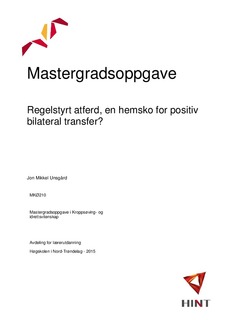Regelstyrt atferd, en hemsko for positiv bilateral transfer?
Master thesis
Permanent lenke
http://hdl.handle.net/11250/286537Utgivelsesdato
2015-07-06Metadata
Vis full innførselSamlinger
Sammendrag
Hensikten med dette studiet var å undersøke om en implisitt og en eksplisitt treningsmetode i pilkast gav ulik effekt på bilateral transfer av læring.
17 forsøkspersoner deltok i undersøkelsen, fordelt i tre grupper: 1) implisitt treningsgruppe, 2) eksplisitt treningsgruppe og 3) kontrollgruppe. Alle gruppene gjennomførte en pretest. Forsøkspersonene i eksplisitt- og implisittgruppene gjennomførte 1400 treningskast i en treningsperiode. Alle gruppene gjennomførte til slutt en posttest. I treningsperioden ble kun dominant hånd trent i en implisitt eller eksplisitt treningsmetode.
Det ble påvist en signifikant framgang på alle gruppene på dominant arm. Med forskjellige læringskurver endte de opp på samme resultat. For nondominant arm fikk både den implisitte gruppen og kontrollgruppen framgang, men eksplisittgruppen fikk en tilbakegang.
Abstract:
The purpose of this present study was to study an implicit and an explicit training method in darts, and get answers to some of these two training methods showed greater bilateral transfer. This research has been done on the basis of general theories around explicit and implicit training theories, and theories surrounding bilateral transfer.
There were 17 subjects who participated in this study. They were divided into three groups: an implicit training group, an explicit training group and a control group. Before they were divided into different training groups they conducted a pretest. Then the implicit group and explicit group respectively followed implicit and explicit training methods, before they conducted a posttest. In the training period the subjects trained only their dominant hand. During the training, the subjects' performance was measured. The control group completed only the pretest and posttest.
It was found a significant progress in all of the groups for the dominant hand. The baseline for the explicit and implicit group was similar. With different learning curves they ended at the same result. Implicit group and the control group also experienced progress on the nondominant hand, but the explicit group received a setback on the nondominant hand in the posttest.
